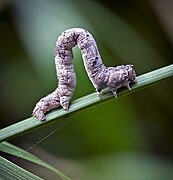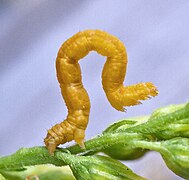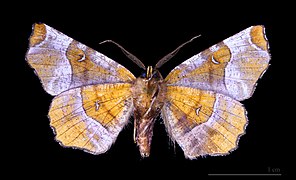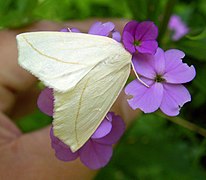Geometer moth
| Geometer moth | |
|---|---|

| |
| Chiasmia species from Ennominae | |
| Scientific classification | |
| Domain: | Eukaryota |
| Kingdom: | Animalia |
| Phylum: | Arthropoda |
| Class: | Insecta |
| Order: | Lepidoptera |
| Superfamily: | Geometroidea |
| Family: | Geometridae Leach, 1815 |
| Subfamilies | |
| |
The geometer moths are moths belonging to the family Geometridae of the insect order Lepidoptera, the moths and butterflies. Their scientific name derives from the Ancient Greek geo γεω (derivative form of γῆ or γαῖα "the earth"), and metron μέτρον "measure" in reference to the way their larvae, or inchworms, appear to measure the earth as they move along in a looping fashion.[1] Geometridae is a very large family, containing around 23,000 described species;[2][3] over 1400 species from six subfamilies are indigenous to North America alone.[1] A well-known member is the peppered moth, Biston betularia, which has been the subject of numerous studies in population genetics. Several other geometer moths are notorious pests.
Caterpillars
The name "Geometridae" ultimately derives from Latin geometra from Greek γεωμέτρης ("geometer", "earth-measurer"). This refers to the means of locomotion of the
-
Locomotion of a looper
-
A geometrid caterpillarcamouflagedas a broken twig
-
Caterpillar locomotion
-
Synchlora aerata caterpillar dressed with pieces of flowers as camouflage
-
Geometrid moth (Geometridae) "inchworm" caterpillar
-
Geometrid moth (Geometridae) "inchworm" caterpillar
Adults
Many geometrids have slender
-
Selenia tetralunaria species from Ennominae
-
Scopula species
-
Tetracis cachexiata in theUS state of Ohio
-
Alsophila pometaria, wingless adult female
Systematics
The placement of the example species follows a 1990 systematic treatment; it may be outdated. Subfamilies are tentatively sorted in a
Larentiinae – about 5,800 species, includes the pug moths, mostly temperate, might be a distinct family.[5][6]
Sterrhinae – about 2,800 species, mostly tropical, might belong to same family as the Larentiinae.[5]
- Birch mocha, Cyclophora albipunctata
- False mocha, Cyclophora porata
- Maiden's blush, Cyclophora punctaria
- Riband wave, Idaea aversata
- Small fan-footed wave, Idaea biselata
- Single-dotted wave, Idaea dimidiata
- Small scallop, Idaea emarginata
- Idaea filicata
- Dwarf cream wave, Idaea fuscovenosa
- Rusty wave, Idaea inquinata
- Purple-bordered gold, Idaea muricata
- Bright wave, Idaea ochrata
- Least carpet, Idaea rusticata
- Small dusty wave, Idaea seriata
- Purple-barred yellow, Lythria cruentaria (formerly in Larentiinae)
- Vestal, Rhodometra sacraria
- Common pink-barred, Rhodostrophia vibicaria
- Middle lace border, Scopula decorata
- Cream wave, Scopula floslactata
- Small blood-vein, Scopula imitaria
- Lewes wave, Scopula immorata
- Lesser cream wave, Scopula immutata
- Mullein wave, Scopula marginepunctata
- Zachera moth, Chiasmia defixaria
- Blood-vein, Timandra comae
- Eastern blood-vein, Timandra griseata
Desmobathrinae – pantropical
Geometrinae – emerald moths, about 2,300 named species, most tropical
Archiearinae – twelve[7] species; holarctic, southern Andes and Tasmania, though the latter some seem to belong to the Ennominae,[6] larvae have all the prolegs but most are reduced.
- Infant, Archiearis infans (Möschler, 1862)
- Scarce infant, Leucobrephos brephoides (Walker, 1857)
Alsophilinae – a few genera, defoliators of trees, might belong in the Ennominae, tribe Boarmiini[6]
- March moth, Alsophila aescularia
- Fall cankerworm, Alsophila pometaria
Ennominae – about 9,700 species, including some defoliating pests, global distribution
- †Eogeometer vadens[4]
Geometridae genera incertae sedis include:
- Dichromodes
- Homoeoctenia
- Nearcha
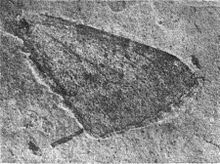
Fossil Geometridae taxa include:
- †Eogeometer Fischer, Michalski & Hausmann, 2019[4]
- †Hydriomena? protrita Cockerell, 1922 (Priabonian, Florissant Formation, Colorado)[8]
- †Geometridites Clark et al., 1971
References
- ^ a b c Robin McLeod, John; Balaban, Jane; Moisset, Beatriz; Entz, Chuck (April 27, 2009). "Family Geometridae - Geometrid Moths". BugGuide. Retrieved April 2, 2011.
- ^ "Lepidoptera Barcode of Life". Archived from the original on 2017-07-12. Retrieved 2017-07-11.
- ^ Scoble, M. J. (1999), Geometrid Moths of the World: A Catalogue (Lepidoptera, Geometridae) (in German), vol. 1 and 2, Stenstrup: CSIRO Publishing and Apollo Books, p. 1016
- ^ PMID 31748672.
- ^ S2CID 85800529.
- ^ .
- ^ "Hemitheini Bruand 1846 - Plazi TreatmentBank". treatment.plazi.org. Retrieved 2024-02-04.
- ^ Cockerell, T. D. A. (1922). "A fossil Moth from Florissant, Colorado". American Museum Novitates (34): 1–2.
Further reading
- Hausmann, A. (2001). The Geometrid Moths of Europe. Vol. 1: Introduction. Archiearinae, Orthostixinae, Desmobathrinae, Alsophilinae, Geometrinae -- v. 4. Larentiinae II (Perizomini and Eupitheciini). Apollo Books.
- Minet, J.; Scoble, M. J. (1999). "17: The Drepanoid / Geometroid Assemblage". In Kristensen, N. P. (ed.). Handbuch der Zoologie. Eine Naturgeschichte der Stämme des Tierreiches / Handbook of Zoology. A Natural History of the phyla of the Animal Kingdom. Vol. 4: Arthropoda: Insecta. Part 35: Lepidoptera, Moths and Butterflies. Vol. 1: Evolution, Systematics, and Biogeography. Berlin & New York: Walter de Gruyter.
- Scoble, M. J., ed. (1999), Geometrid Moths of the World: A Catalogue, ISBN 0-643-06304-8
External links
- "Family Geometridae" at Insecta.pro
- Anacamptodes pergracilis, cypress looper on the University of Florida / Institute of Food and Agricultural Sciences Featured Creatures website
- Geometridae species in New Zealand Archived 2015-11-07 at the Wayback Machine
- Geometridae species in Portugal




